Which of the Following Fashion Styles Focus on Nature and Environment
The Environmental Toll of Fashion
The style industry stand for an of import office of our economies, with a value of more than than 2.5 trillion $USD and employing over 75 million people worldwide. The sector has seen spectacular growth over the by decades, as clothing production doubled betwixt 2000 and 2014. While people bought threescore% more garments in 2014 than in 2000, they only kept the clothes for half as long (McKinsey & Company, 2016).
While the fashion sector is booming, increasing attending has been brought to the impressive range of negative environmental impacts that the industry is responsible for. Style production makes up x% of humanity'south carbon emissions, dries upward water sources, and pollutes rivers and streams. What's more, 85% of all textiles go to the dump each year (UNECE, 2018), and washing some types of clothes sends significant amount of microplastics into the sea.
The Environmental Footprint of Fast Mode
- The equivalent of one garbage truck full of wearing apparel is burned or dumped in a landfill every second (UNEP, 2018)
- Approximately sixty% of all materials used by the fashion industry are made from plastic (UNEP, 2019)
- 500,000 tons of microfibers are released into the ocean each twelvemonth from washing dress — the equivalent of 50 billion plastic bottles (Ellen MacArthur Foundation, 2017)
- The manner manufacture is responsible for 8-10% of humanity's carbon emissions – more than all international flights and maritime shipping combined (UNEP, 2018). If the fashion sector continues on its current trajectory, that share of the carbon budget could jump to 26% by 2050 (Ellen MacArthur Foundation, 2017)
- Some 93 billion cubic metres of h2o – enough to come across the needs of 5 million people – is used by the fashion manufacture annually, contributing significantly to h2o scarcity in some regions (UNCTAD, 2020)
- Effectually 20% of industrial wastewater pollution worldwide originates from the style industry (WRI, 2017)
More facts and sources on Business Insider
Fast fashion also has a human price: textile workers, primarly women in developing countries, are frequently paid derisory wages and forced to work long hours in appalling conditions (UNEP, 2018; WRI, 2019). In many places, these weather condition create infringements on human rights (Man Rights Spotter). Apply of chemicals in clothes production also heighten serious health concerns, both for the workers in the manufacture and consumers. Boosted impacts on health also arise from the pollution described previously.
The ecology and social cost of the fashion manufacture forces us to rethink fast fashion, and stresses the need for more sustainable business organisation models and practices. Resource hereunder provide additional information on the environmental impacts of fashion, and potential pathways for change.
- Chile's Atacama Desert: Where Fast Manner Goes to Die | EcoWatch | 15 November 2021
- Constructive regulations? Environmental impact cess in the textile and garment sector in Bangladesh, Kingdom of cambodia, Republic of indonesia and Viet Nam | ILO | 14 June 2021
- Can an finish-to-end sustainability standard change fashion? | VogueBusiness | 18 March 2021
- Plastic microfibres illustrate the challenges of fighting marine litter | Grid-Arendal | 4 March 2021
- Fast manner speeding toward environmental disaster, report warns | The Guardian | 7 April 2020
- Can fashion ever exist sustainable? | BBC | 11 March 2020
- These facts testify how unsustainable the fashion industry is | World Economical Forum | 31 January 2020
- The huge price of 'fast fashion' on the planet – and why the answer could be circular | National Geographic | four July 2019
- Fashion'south tiny subconscious surreptitious | UNEP | xiii March 2019
- By the numbers: the economical, social and environmental impacts of "fast manner" | WRI | ten January 2019
- The global environmental injustice of fast mode | Bick et al. | Environmental Health | 27 December 2018
- Putting the brakes on fast fashion | UNEP | 12 November 2018
- Fashion is an environmental and social emergency, but tin also drive progress towards the Sustainable Evolution Goals | UNECE | 1 March 2018
- Timeout for fast fashion | Greenpeace
International Cooperation on Sustainable Manner
As fashion value chains are globalized and the industry has a significant bear on on the accomplishment of the United nations Sustainable Development Goals (SDGs), international cooperation is important to foster sustainable mode.
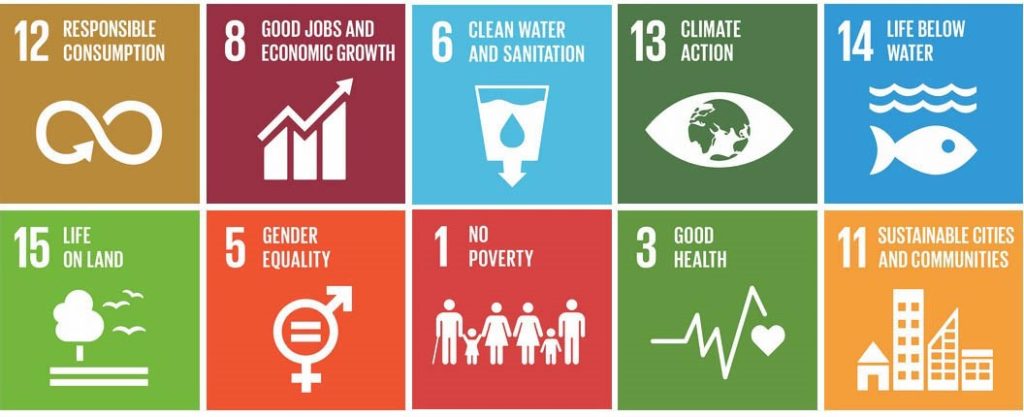
Impact of the way manufacture on the SDGs (UNECE, 2018)
Launched at the fourth United nations Environment Associates (UNEA-4), the UN Alliance for Sustainable Way is seeking to halt the environmentally and socially destructive practices of mode. The Alliance is improving collaboration amid United nations agencies by analyzing their efforts in making style sustainable, identifying solutions and gaps in their deportment, and presenting these findings to governments to trigger policy. Additionally, the Forests for Fashion Initiative, led by UNECE, FAO, and partners, supports innovative solutions in mode through sustainable forests-based materials. Several other international organizations are working on global efforts to foster more sustainable fashion. Additional information on these initiatives can be found in the links beneath.
- The UN Brotherhood for sustainable style
- Traceability for Sustainable Garment and Footwear | UNECE
- Ethical Fashion Initiative | ITC
- CNMI and EFI announce launch of joint ESG Framework for manner and 2022 Sustainable Fashion Awards | ITC EFI | 26 September 2021
- UNECE launches 'The Sustainability Pledge' for measurable and verifiable sustainability in the garment and footwear sector | UNECE | 20 May 2021
- Call to Action for Traceability, Transparency, Sustainability and Circularity of Value Bondage in the Garment and Footwear Sector | UNECE | xi March 2021
- Enhancing Traceability and Transparency of Sustainable Value Chains in the Garment and Footwear Sector | UNECE | viii February 2021
- Sustainability and Circularity in the Textile Value Chain | UNEP | October 2020
- Transparency and Traceability tin back up the fashion industry's mail service-COVID recovery toward resilient and sustainable value chains | UNCTAD | 21 September 2020
- On tendency: sustainable fashion in the wake of COVID-19 | UNEP | 16 June 2020
- UNECE traceability initiative can accelerate manner industry's shift to more sustainable and round model | UNECE | 21 February 2020
- SAICM details efforts to reduce chemicals of concern in textiles, toys, building materials and electronics | IISD | six January 2020
- Edifice Circularity in the Textile Value Chain | 1 Planet Network | 1 August 2019
- UN launches drive to highlight environmental cost of staying fashionable | Un News | 25 March 2019
- Forests for Fashion initiative sets new trends | UNECE | xv March 2019
- UN Alliance For Sustainable Fashion addresses harm of 'fast fashion' | UNEP | 14 March 2019
- The future of work in textiles, clothing, leather and footwear | ILO | 2019
- Made in Forests | Un with Goodwill Administrator Michelle Yeoh | 16 July 2018
- A new textiles economic system : redesigning fashion's future | Ellen MacArthur Foundation | 2017
- UNCTAD establishes three partnerships to boost fashion manufacture´s back up of biodiversity | UNCTAD | 1 June 2011
- Subscribe to UNEP'southward textiles newsletter
World Cotton Twenty-four hours
Cotton fiber is one of the most mutual fabrics used for clothes. Producing cotton sustains the livelihood of 28.67 million people and provides benefits to over 100 million families across the globe (WTO, 2020). Recognizing the critical role of cotton fiber for economic development, international merchandise, and poverty alleviation, the Un General Assembly decided to proclaim World Cotton fiber Day on seven October (A/RES/75/318).
For its beginning edition, the day aims to highlight the importance of sustained, inclusive and sustainable economic growth, full and productive employment and decent work for all in the cotton sector. Many actors in Geneva are involved in promoting sustainable production and consumption patterns in the cotton fiber industry (see section below for details).
Cotton production can have consequent impacts on the planet due to the use of pesticides, high water consumption, and the conversion of habitat to agronomical utilize. Conventional product practices can outcome in soil erosion and degradation, water contamination, and other forms of pollution. Therefore, supporting sustainable models of cotton wool product is essential if we are to achieve the SDGs. Learn more about environmental sustainability in the cotton wool sector through the resources below.
- Earth Cotton wool Day | UN
- Why cotton fiber? Facts & figures | WTO
- WTO, ITC and UNCTAD initiative on cotton past-products | WTO
- Cotton: Impacts & Activity | WWF
- Better Cotton Initiative
- Measuring Sustainability in Cotton Farming Systems | FAO & ICAC | 2015
Sustainable Fashion in Geneva
Past alphabetical order
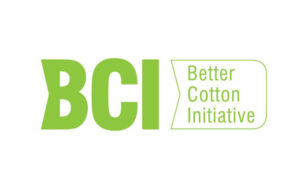
Better Cotton fiber Initiative
The Amend Cotton Initiative (BCI), the largest cotton sustainability programme in the world, aims to brand global cotton wool production better for the people who produce it, better for the environment it grows in and ameliorate for the sector's future.
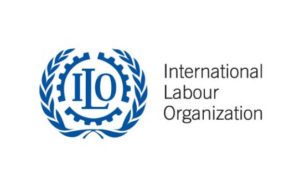
International Labour Organization
ILO promotes decent work in the textiles, vesture, leather and footwear sector through social dialogue, noesis sharing, international labour standards, capacity building, partnerships and policy back up.
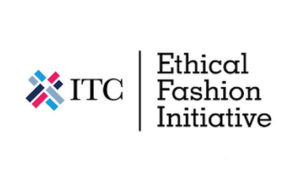
ITC Ethical Fashion Initiative
EFI is a flagship programme of the International Merchandise Center, which connects marginalised artisans from the developing world – the majority of them women – to international fashion houses for mutual benefit. EFI too hosts the Secretariat of the Un Alliance for Sustainable Manner


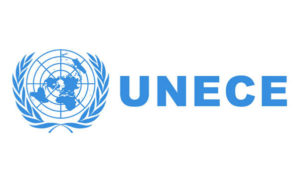
United Nations Economic Committee for Europe
UNECE's work on trade in the textile and leather sector focuses on improving transparency and traceability in social club to place and address labor and human rights violations and ecology impacts while embracing more sustainable production and consumption patterns. UNECE too promotes sustainable innovation in the mode sector through its work on sustainable woods products.

Un system's engagement is larger than the Geneva-based organizations presented here. Members of the Un Alliance for Sustainable Fashion too include UNDP, UNEP, United nations Global Compact, UNFCCC and UNOPS.
What Tin I Do?
While international organizations, governments and businesses work on solutions to shift the way industry toward a more than sustainable pathway, consumers can also play a role with their daily actions. This section provides resources on the actions individuals can accept to support sustainability in their clothes choices.
- Responsible purchasing | Metropolis of Geneva
- Ge-reutilise – Directory of 2d paw and rental shops | City of Geneva
- Labels and norms in Fashion | Public Middle
- Where to notice information on fairer manner| Public Eye
- Guide du shopping éthique (in French) | Nice Hereafter
Links
Further resources and events to learn about environmental sustainability in the fashion industry are provided below. This page is regularly updated.
- The Dress We Wearable | Wednesdays for the Planet | Geneva Environment Network | 17 March 2021
0 Response to "Which of the Following Fashion Styles Focus on Nature and Environment"
Post a Comment